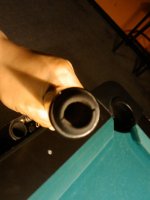I do ultrasound and have a degree in that. Waves travel at different velocities in different materials, and when two materials that have what is called a significant z difference, or sound speed is different through them, energy is absorbed at the interface and is lost as heat. Also, on ultrasound probes, rubber is used as a dampener which kills vibration between pulses. That being said, taking the rubber bumper out and having that make a difference in the hit of a cue depends on how much vibration is left after energy waves have gone all the way through the several interfaces of a typical two piece cue. Maybe you should attach some kind of oscilloscope to the end of the cue with and without bumper to see the difference. Dampening is a funny thing, it can result in more range of wave frequencies during a particular length of time because, like grabbing a rung bell, the sound goes from its highest frequency to the lowest possible, zero, in the time it takes to dampen it. If you strike a cueball, then during that contact time fewer frequencies would be transmitted with an undampened, bumperless cue (transmitted to the hands or back into the cueball.) Several issues come up due to this, like energy transfer and loss, and feedback ("information" is what Kent Davis the cuemaker calls it.) Without experiments, a whole lot of side issue science pops up and you can end up with more questions than answers. This is complicated I know, so I will leave it at this for now; theoretically an undampened cue retains more energy which could potentially be transmitted back to the cue ball during contact time.
Wow! And I was just going to see which feel I liked if there is really any differance.
